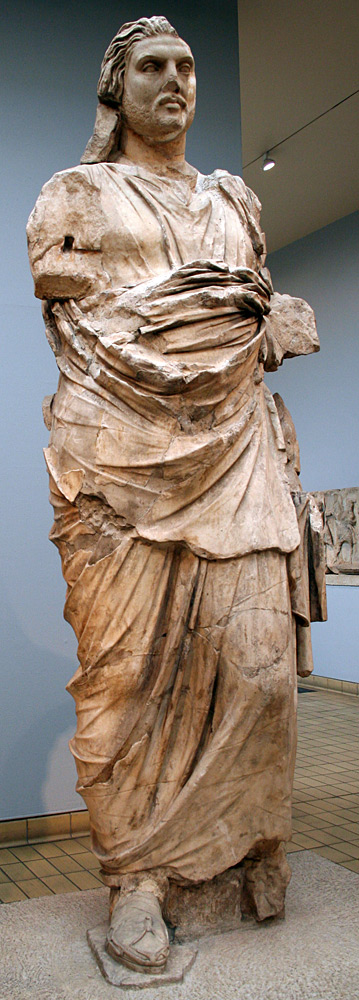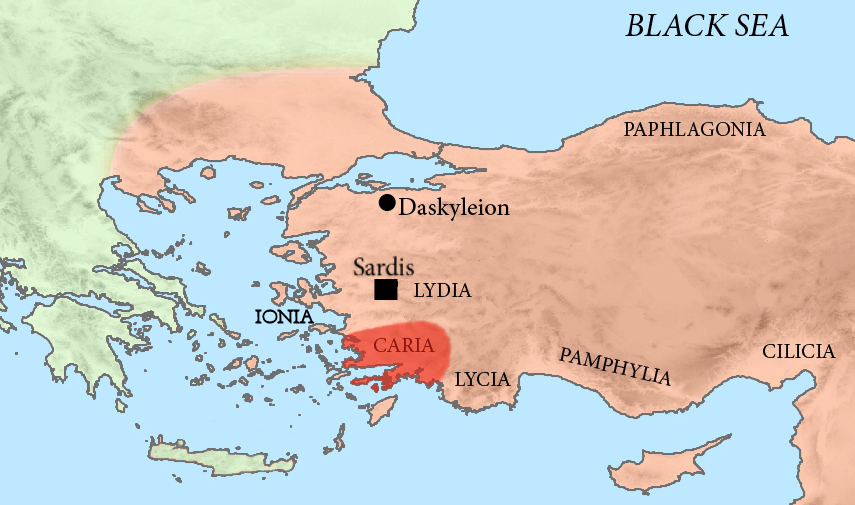Hecatomnid on:
[Wikipedia]
[Google]
[Amazon]

 The Hecatomnid dynasty or Hecatomnids were the rulers of
The Hecatomnid dynasty or Hecatomnids were the rulers of
at livius.org

 The Hecatomnid dynasty or Hecatomnids were the rulers of
The Hecatomnid dynasty or Hecatomnids were the rulers of Caria
Caria (; from Greek: Καρία, ''Karia''; tr, Karya) was a region of western Anatolia extending along the coast from mid-Ionia (Mycale) south to Lycia and east to Phrygia. The Ionians, Ionian and Dorians, Dorian Greeks colonized the west of i ...
and surrounding areas BCE.
The Hecatomnids were satraps
A satrap () was a governor of the province
A province is almost always an administrative division within a country or state. The term derives from the ancient Roman '' provincia'', which was the major territorial and administrative unit of ...
(governors) under the Achaemenid Empire
The Achaemenid Empire or Achaemenian Empire (; peo, 𐎧𐏁𐏂, , ), also called the First Persian Empire, was an ancient Iranian empire founded by Cyrus the Great in 550 BC. Based in Western Asia, it was contemporarily the largest em ...
, although they ruled with considerable autonomy, and established a hereditary dynasty. The first satrap of the dynasty was Hecatomnus
Hecatomnus of Mylasa or Hekatomnos ( el, Ἑκατόμνος, Carian: 𐊴𐊭𐊪𐊵𐊫 ''k̂tmno'' “under-son, descendant(?)”) was an early 4th-century BC ruler of Caria. He was the satrap (governor) of Caria for the Persian Achaemenid ...
. He was appointed as the first Carian satrap of Caria in the late 390s BCE. Previously, Caria had been governed as part of Lydia
Lydia (Lydian language, Lydian: ‎𐤮𐤱𐤠𐤭𐤣𐤠, ''Śfarda''; Aramaic: ''Lydia''; el, Λυδία, ''Lȳdíā''; tr, Lidya) was an Iron Age Monarchy, kingdom of western Asia Minor located generally east of ancient Ionia in the mod ...
, by the satrap Tissaphernes
Tissaphernes ( peo, *Ciçafarnāʰ; grc-gre, Τισσαφέρνης; xlc, 𐊋𐊆𐊈𐊈𐊀𐊓𐊕𐊑𐊏𐊀 , ; 445395 BC) was a Persian soldier and statesman, Satrap of Lydia and Ionia. His life is mostly known from the works of Thucy ...
based in Sardis
Sardis () or Sardes (; Lydian: 𐤳𐤱𐤠𐤭𐤣 ''Sfard''; el, Σάρδεις ''Sardeis''; peo, Sparda; hbo, ספרד ''Sfarad'') was an ancient city at the location of modern ''Sart'' (Sartmahmut before 19 October 2005), near Salihli, ...
. Tissaphernes was executed by Tithraustes
Tithraustes ( Old Persian: ; Ancient Greek: ) was the Persian satrap of Sardis for several years in the early 4th century BC. Due to scanty historical records, little is known of the man or his activities. He was sent out from Susa to replace ...
on the orders of Artaxerxes II Memnon
Arses ( grc-gre, Ἄρσης; 445 – 359/8 BC), known by his regnal name Artaxerxes II ( peo, 𐎠𐎼𐎫𐎧𐏁𐏂 ; grc-gre, Ἀρταξέρξης), was King of Kings of the Achaemenid Empire from 405/4 BC to 358 BC. He was the son and s ...
in 395 BCE. If Hecatomnus did not become satrap immediately upon the death of Tissaphernes, he was in office by 392 BCE, when he made war on Evagoras of Salamis on the orders of Artaxerxes II Memnon.
Hecatomnus therefore became satrap of Caria BCE. He was previously one of many minor dynasts in Caria. The Hecatomnid dynasty's seat was originally Mylasa
Milas ( grc, Μύλασα, Mylasa) is an ancient city and the seat of the district of the same name in Muğla Province in southwestern Turkey. The city commands a region with an active economy and very rich in history and ancient remains, the ter ...
, in central Caria. Hecatomnus' father, Hyssaldomus, was also an independent dynast based in Mylasa, and issued coinage with Mylasan types, labelled with his initial in the Carian language.
It was moved to Halicarnassus
Halicarnassus (; grc, Ἁλικαρνᾱσσός ''Halikarnāssós'' or ''Alikarnāssós''; tr, Halikarnas; Carian: 𐊠𐊣𐊫𐊰 𐊴𐊠𐊥𐊵𐊫𐊰 ''alos k̂arnos'') was an ancient Greek city in Caria, in Anatolia. It was located i ...
, the former seat of the Lygdamid dynasty
The Lygdamid dynasty ( BCE) was a dynasty of tyrants in the region of Caria, who were subordinate to the Achaemenid Empire following the conquests of Cyrus the Great through his general Harpagus. The dynasty was founded by Lygdamis, of Carian- ...
( BCE), by Mausolus
Mausolus ( grc, ╬£╬▒╧ì╧â╧ë╬╗╬┐╧é or , xcr, Éè¬≡ÉèáÉè▓≡Éè╕≡Éè½≡Éèª ''Mau┼¢o╬╗'') was a ruler of Caria (377ΓÇô353 BCE) and a satrap of the Achaemenid Empire. He enjoyed the status of king or dynast by virtue of the powerful position created by h ...
and Artemisia
Artemisia may refer to:
People
* Artemisia I of Caria (fl. 480 BC), queen of Halicarnassus under the First Persian Empire, naval commander during the second Persian invasion of Greece
* Artemisia II of Caria (died 350 BC), queen of Caria under th ...
in the early 370s BCE.
Mausolus and Artemisia succeeded their father upon his death in 377 BCE.
Hecatomnus' five children succeeded him in succession. The dynasty engaged in sibling marriage, presumably to preserve royal power within the family. During the government of the Hecatomnids, both, wife like husband assumed as equally accepted rulers, and the widower of the couple would assume as the sole regnant after his or her partner deceased.
The dynasty ended in 334 BC with the conquests of Alexander the Great
Alexander III of Macedon ( grc, wikt:Ἀλέξανδρος, Ἀλέξανδρος, Alexandros; 20/21 July 356 BC – 10/11 June 323 BC), commonly known as Alexander the Great, was a king of the Ancient Greece, ancient Greek kingdom of Maced ...
. Ada
Ada may refer to:
Places
Africa
* Ada Foah, a town in Ghana
* Ada (Ghana parliament constituency)
* Ada, Osun, a town in Nigeria
Asia
* Ada, Urmia, a village in West Azerbaijan Province, Iran
* Ada, Karaman, a village in Karaman Province, ...
adopted him as her son, so that he would succeed to the rule of Caria.
The best-known monument of the dynasty is the Mausoleum
A mausoleum is an external free-standing building constructed as a monument enclosing the interment space or burial chamber of a deceased person or people. A mausoleum without the person's remains is called a cenotaph. A mausoleum may be consid ...
that Artemisia II built in honor of her husband and brother Mausolus.
After the death of Pixodarus, the last member of the Hecatomnids, Orontobates
Orontobates ( Old Persian: , Ancient Greek: ; lived 4th century BC) was a Persian, who married the daughter of Pixodarus, the usurping satrap of Caria, and was sent by the king of Persia to succeed him.
Biography
On the approach of Alexander t ...
was sent by the king of Persia
Iran, officially the Islamic Republic of Iran, and also called Persia, is a country located in Western Asia. It is bordered by Iraq and Turkey to the west, by Azerbaijan and Armenia to the northwest, by the Caspian Sea and Turkmeni ...
to succeed him. Orontobates, a Persian
Persian may refer to:
* People and things from Iran, historically called ''Persia'' in the English language
** Persians, the majority ethnic group in Iran, not to be conflated with the Iranic peoples
** Persian language, an Iranian language of the ...
, married the daughter of Pixodarus
Pixodarus or Pixodaros (in Lycian 𐊓𐊆𐊜𐊁𐊅𐊀𐊕𐊀 ''Pixedara''; in Greek Πιξώδαρoς; ruled 340–334 BC), was a satrap of Caria, nominally the Achaemenid Empire Satrap, who enjoyed the status of king or dynast by virtu ...
, and ruled from 335 to 334.
After the conquest of Alexander the Great
Alexander III of Macedon ( grc, wikt:Ἀλέξανδρος, Ἀλέξανδρος, Alexandros; 20/21 July 356 BC – 10/11 June 323 BC), commonly known as Alexander the Great, was a king of the Ancient Greece, ancient Greek kingdom of Maced ...
, Ada again ruled from 334 to 326 under the Macedonian Empire
Macedonia (; grc-gre, Μακεδονία), also called Macedon (), was an ancient kingdom on the periphery of Archaic and Classical Greece, and later the dominant state of Hellenistic Greece. The kingdom was founded and initially ruled ...
.
Members
*Hecatomnus
Hecatomnus of Mylasa or Hekatomnos ( el, Ἑκατόμνος, Carian: 𐊴𐊭𐊪𐊵𐊫 ''k̂tmno'' “under-son, descendant(?)”) was an early 4th-century BC ruler of Caria. He was the satrap (governor) of Caria for the Persian Achaemenid ...
, ruled 395ΓÇô377
* Mausolus
Mausolus ( grc, ╬£╬▒╧ì╧â╧ë╬╗╬┐╧é or , xcr, Éè¬≡ÉèáÉè▓≡Éè╕≡Éè½≡Éèª ''Mau┼¢o╬╗'') was a ruler of Caria (377ΓÇô353 BCE) and a satrap of the Achaemenid Empire. He enjoyed the status of king or dynast by virtue of the powerful position created by h ...
and Artemisia II, intermarried son and daughter of Hecatomnus, ruled 377ΓÇô353
* Artemisia II, daughter of Hecatomnus, wife of Mausolus
Mausolus ( grc, ╬£╬▒╧ì╧â╧ë╬╗╬┐╧é or , xcr, Éè¬≡ÉèáÉè▓≡Éè╕≡Éè½≡Éèª ''Mau┼¢o╬╗'') was a ruler of Caria (377ΓÇô353 BCE) and a satrap of the Achaemenid Empire. He enjoyed the status of king or dynast by virtue of the powerful position created by h ...
, ruled 353ΓÇô351
* Idrieus
Idrieus, or Hidrieus ( grc, Ἱδριεύς, Hidrieús; died 344 BC) was a ruler of Caria as a Satrap under the Achaemenid Empire. Alongside his sister and wife Ada, he enjoyed the status of king or dynast by virtue of the powerful position he ...
, son of Hecatomnus, ruled 351ΓÇô344
* Ada
Ada may refer to:
Places
Africa
* Ada Foah, a town in Ghana
* Ada (Ghana parliament constituency)
* Ada, Osun, a town in Nigeria
Asia
* Ada, Urmia, a village in West Azerbaijan Province, Iran
* Ada, Karaman, a village in Karaman Province, ...
, daughter of Hecatomnus, wife of Idrieus, ruled 344ΓÇô340 and 334ΓÇô326 (under Alexander the Great
Alexander III of Macedon ( grc, wikt:Ἀλέξανδρος, Ἀλέξανδρος, Alexandros; 20/21 July 356 BC – 10/11 June 323 BC), commonly known as Alexander the Great, was a king of the Ancient Greece, ancient Greek kingdom of Maced ...
)
* Pixodarus
Pixodarus or Pixodaros (in Lycian 𐊓𐊆𐊜𐊁𐊅𐊀𐊕𐊀 ''Pixedara''; in Greek Πιξώδαρoς; ruled 340–334 BC), was a satrap of Caria, nominally the Achaemenid Empire Satrap, who enjoyed the status of king or dynast by virtu ...
, son of Hecatomnus, ruled 340ΓÇô335
:(Orontobates
Orontobates ( Old Persian: , Ancient Greek: ; lived 4th century BC) was a Persian, who married the daughter of Pixodarus, the usurping satrap of Caria, and was sent by the king of Persia to succeed him.
Biography
On the approach of Alexander t ...
, Achaemenid Satrap), ruled 335-334
* Ada (second reign), ruled 334-326 under the Macedonian Empire
Macedonia (; grc-gre, Μακεδονία), also called Macedon (), was an ancient kingdom on the periphery of Archaic and Classical Greece, and later the dominant state of Hellenistic Greece. The kingdom was founded and initially ruled ...
Family tree
Bibliography
* Simon Hornblower, ''Mausolus'', Clarendon Press, 1982, * "Hecatomnid dynastyat livius.org
References